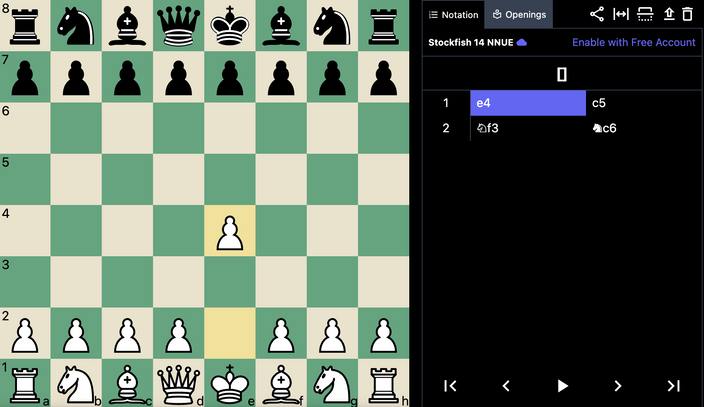
Algebraic chess notation is the standard way to record and communicate chess moves. It is easy to learn, simple to use, and universally understood by both humans and computers. This article will explain how to read and write algebraic chess notation.
Algebraic chess notation has been around for centuries and was standardized in the late 19th century. It is the most popular way to notate chess moves and is used by players of all levels, from beginners to grandmasters.
Learning Chess Notation is Easy
Below is the algebraic notation for the first 4 plys or half-moves of a Sicilian Defense.
1. e4 c5 2. Nf3 Nc6
To read chess notation each ply consists of two main parts the piece, and the square it's moving to. The square is named by a coordinate system with the ranks (rows) numbered 1-8 and the files (columns) lettered A-H originating from the bottom left corner from white's perspective. The piece is abbreviated with a single capital letter.
K = King
Q = Queen
R = Rook
B = Bishop
N = Knight
If no piece is named it's assumed that a pawn move is made. Notice also how the Knight is abbreviated with a "N" not "K".
So in our Sicilian example `1. e4 c5` can be read pawn to e4 for white and pawn to c5 for black. Then `2. Nf3 Nc6` Reads knight to f3 and knight to c6. Which would leave us in this state.

Great! You're getting the hang of it and probably wondering how to notate castling or capturing pieces. Let's follow the next moves of the Sicilian Nimzovich-Rossolimo attack.
3. Bb5 g6 4. O-O
On move 4 white makes a special move and castles kingside. This is move is noted O-O. If you want to write queenside or long castling it is notated O-O-O. You can remember the difference in syntax by equating the longer notation to the long distance between the king and rook on the queenside.
Fast-forwarding a few standard moves we arrive at this position below where black intends to capture white's pawn on d4. This is written cxd4. Where x means to capture. In practice, this is read as "c" takes "d4".

In this same position, if black somehow totally blundered and took d4 with the knight it would be written Nxd4. If you need to distinguish between which of the two knights or rooks can take a piece. That is written like Ncxd4 or Nc6xd4. Where "Nc" denotes the piece and file or longhand "Nc6" the piece and square.
You might be asking, what about promotion? That's simple just note the piece and square like any other move and append "=" and the letter representing the piece to promote to. Let's look at an example from Fischer - Spassky 1992.

Spassky played pawn to b1 promoting to a queen. This is written b1=Q.
The last pieces of notation to understand are "+" and "#". A "+" is used to show that a player has made a check. And a "#" is used to show that the player has placed their opponent in checkmate. So if we see Nf7+ it means that white moved a knight to f7 and placed black in check. If the move resulted in checkmate it would be written Nf7# or Nf7++ is an alternative syntax.
Chess annotation symbols
Along with algebraic notation, it is common to see evaluation symbols added to individual half-moves either by the player when recording the game or through post-game analysis. For example a brilliant move promoting to a knight resulting in check would be notated c8=N+!!. These annotations are subjective in nature but vital for capturing the emotion of the position.
! Good move
!! Brilliant move
? Mistake
?? Blunder
!? Interesting move
?! Dubious move
Now you should have all the tools you need to read and write standard algebraic chess notation! Explore our selection of chess books and scorebooks to practice what you just learned.